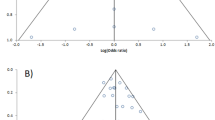Abstract
Effect Sizes (ES) are an increasingly important index used toquantify the degree of practical significanceof study results. This paper gives anintroduction to the computation andinterpretation of effect sizes from theperspective of the consumer of the researchliterature. The key points made are:1. ES is a useful indicator of the practical(clinical) importance of research resultsthat can be operationally defined frombeing ``negligible'' to ``moderate'', to``important''.2. The ES has two advantages overstatistical significance testing: (a) itis independent of the size of the sample;(b) it is a scale-free index. Therefore,ES can be uniformly interpreted indifferent studies regardless of the samplesize and the original scales of thevariables.3. Calculations of the ES are illustrated byusing examples of comparisons between twomeans, correlation coefficients,chi-square tests and two proportions,along with appropriate formulas.4. Operational definitions for the ESs aregiven, along with numerical examples forthe purpose of illustration.
Similar content being viewed by others
References
American Psychological Association (2001). Publication Manual of the American Psychological Association (5th edition). Washington, DC: American Psychological Association.
Cohen, J. (1987). Statistical Power Analysis for Behavioral Sciences. Hillsdale, NJ: Erlbaum.
Owen, S.B. (1962). Handbook of Statistical Tables. Reading, MA: Addison-Wesley.
Dunlap, W.P., Cortina, J.M., Vaslow, J.B. & Burke, M.J. (1996). Meta-analysis of experiments with matched groups or repeated measure designs. Psychological Methods 1: 170–177.
Friedman, H. (1968). Magnitude of experimental effect and a table for its rapid estimation.Psychological Bulletin 70: 245–253.
Gibbons, R.D., Hedeker, D.R. & Davis, J.M. (1993). Estimation of effect size from a series of experiments involving paired comparisons. Journal of Educational Statistics 18: 271–279.
Glass, G.V., McGaw, B. & Smith, M.L. (1981). Meta-Analysis in Social Research. Beverly Hills, CA.
Hedges, L.V. (1981). Distribution theory for Glass's estimator of effect size and related measures.Journal of Educational Statistics 6: 107–128.
Hedges, L.V. (1982). Estimation of effect size from a series of independent experiments. Psychological Bulletin 92: 490–499.
Hedges, L.V. & Olkin, I. (1985). Statistical Methods for Meta-Analysis. New York: Academic Press.
Jacobson, N.S. & Truax, P. (1991). Clinical significance: a statistical approach to defining meaningful change in psychotherapy research. Journal of Consulting and Clinical Psychology 59: 12–19.
Kirk, R. (1996). Practical significance: a concept whose time has come. Educational and Psychological Measurement 56: 746–759.
Morris, S.B. (2002). Distribution of the standardized mean change effect size for meta-analysis on repeated measures. British Journal of Mathematical and Statistical Psychology 53: 17–29.
Morris, S.B. (2002). Combining effect size estimates in meta-analysis with repeated measures and independent-groups designs. Psychological Methods 7: 105–125.
Rosenthal, R. & Rosnow, R.L. (1991). Essentials of Behavioral Research: Methods and Data Analysis. New York: McGraw Hill.
Rosnow, R.L. & Rosenthal, R. (1996). Computing contrasts, effect sizes, and counternulls on other people's published data: general procedures for research consumers. Psychological Methods 1: 331–340.
Author information
Authors and Affiliations
Corresponding author
Rights and permissions
About this article
Cite this article
Hojat, M., Xu, G. A Visitor's Guide to Effect Sizes – Statistical Significance Versus Practical (Clinical) Importance of Research Findings. Adv Health Sci Educ Theory Pract 9, 241–249 (2004). https://doi.org/10.1023/B:AHSE.0000038173.00909.f6
Issue Date:
DOI: https://doi.org/10.1023/B:AHSE.0000038173.00909.f6




